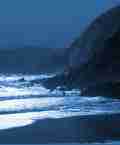 |
Search the site:

Walking Ireland’s MountainsThe South-EastThere was one particularly fine view over the inset Loch Muskry (a classic armchair corrie complete with water cushion) along to the cone of Galtymore. O'Loughman's Castle was very clear: a squat, square, crenellated tower until it is approached off Greenane when it disintegrates, as if by magic, into a crumbly conglomerate outcrop. It must be a place of legends. The small mountain ranges of the South-East are with one exception composed of either old red sandstone or Silurian rock. They are somewhat subdued in form but nonetheless surprisingly high, and boast one of Ireland's few Munros (peaks over 914 metres/3,000 feet high). Unusually for-Ireland, all the ranges are outside the ambience of the sea: they mostly rise from rich, well-populated, cultivated land and wide, coniferous plantations. One other general point: the Galtees, Knockmealdowns and the Comeraghs are quite close to each other, none too demanding and have plenty of varied accommodation around them. The South-East extract from Walking Ireland's Mountains continues:
Route 9: Slieve Blooms
Start at Glenbarrow car park off R422 (S 368082). Take Slieve Bloom Way down to nearby river and continue on track (not shown on map) and road to the Cut (a high point on minor road crossing range). Turn left here to climb Barna, Baunreaghcong, Carnahinch. Walk north-east to rejoin Way at large cairn, then follow rough path whose route is indicated by tall poles across some wet terrain. Forest tracks, still on way, to end.
Route 10
Route 11
Route 12
Route 13
Route 14
Route 15
|
[ Back to Top ]
All Material © 1999-2004 Irelandseye.com and contributors
